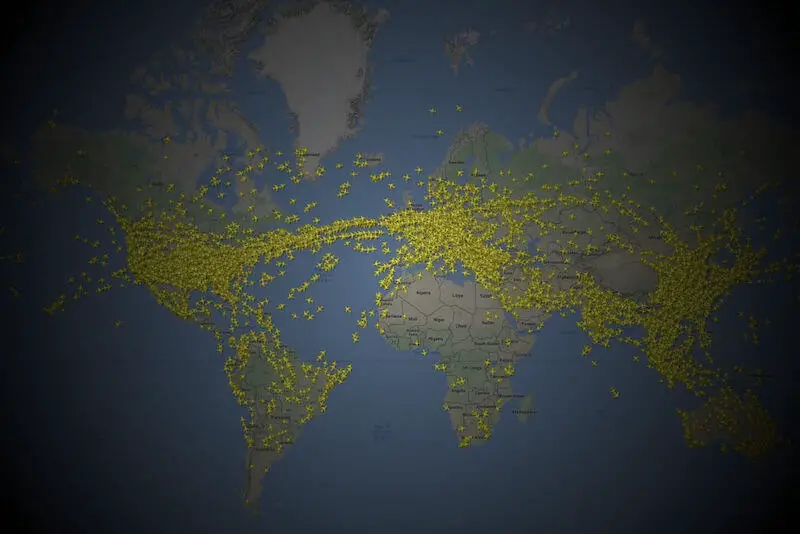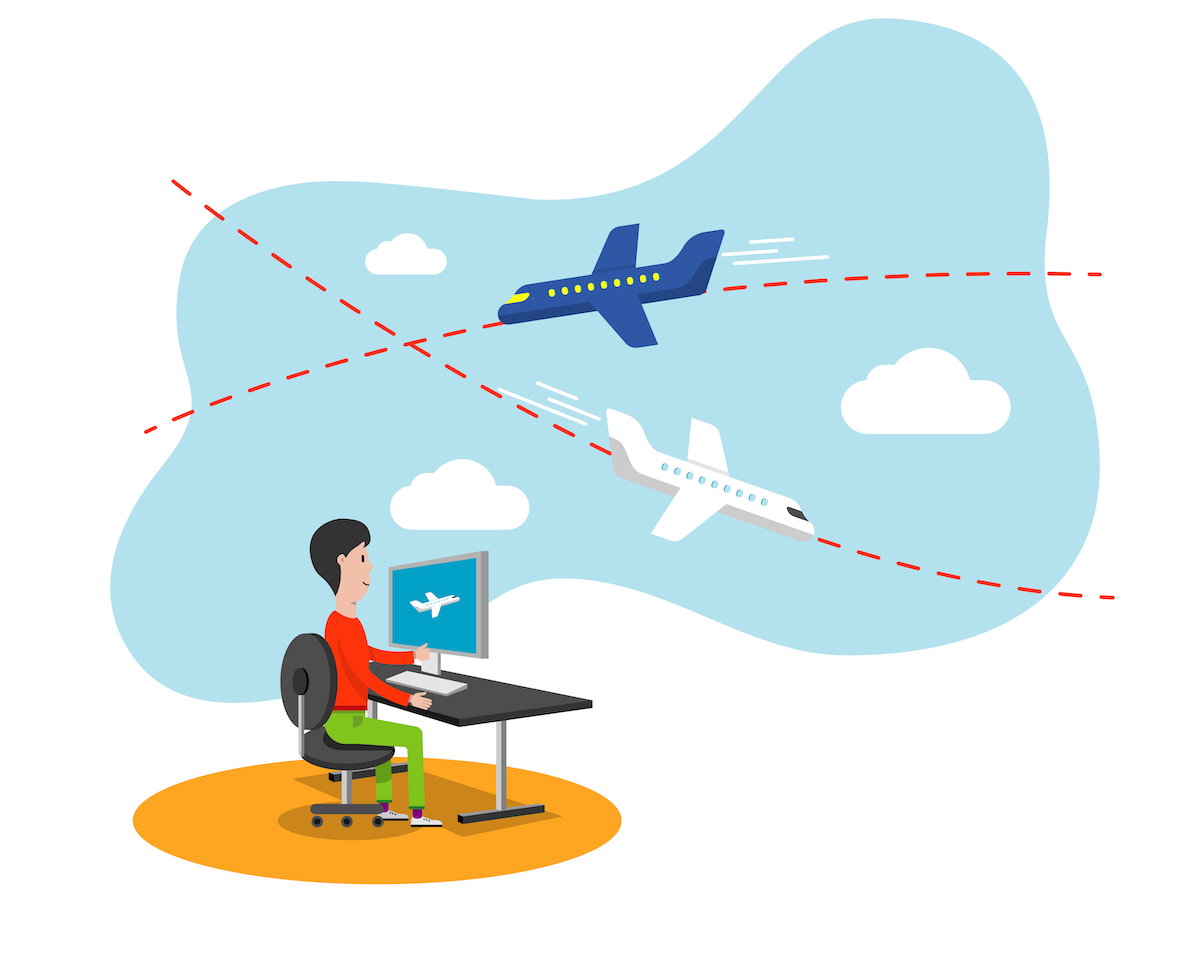

Until recently, the ability to use a flight tracker from the ground was reserved for professionals in certain fields. Without specialised training in flight control, your average citizen could not track flights any farther than from one horizon to the other. With the help of binoculars or a spotting scope, you might also be able to tell the name of the airline and (if you were a pro) the type of aircraft. Now that every aspect of our lives has been digitised, anyone who wants to can get an up-close and accurate look at air traffic. Anyone can use flight trackers and pull up all sorts of information on their screen – everything from the type of aircraft to the precise flight route, as well as take-off and landing times.
Tracking flights on the Internet
The Internet allows anyone who is connected to it to access various flight tracking services using a smartphone, tablet or desktop. The Web holds information on all the civil flights around the world. Anyone can look it up free and on demand and track flights for as long as they want. The only cost involved is for the Internet connection, which they’re already paying anyway. Probably the best-known flight tracking service is flightradar24.com. This leading flight radar provider is becoming more and more professional. In addition to the existing map views, they now also offer detailed information on specific flights. For example, if an unusual flight delay occurs due to storms, technical issues or military conflicts, flightradar24 operators will extract the data for a specific flight. They then supply this information to the media, for example, making it possible to retrace the circumstances surrounding this flight and help try to clarify unusual events, etc.
Flight tracker – what other service providers are available?
So far we’ve mentioned the services of flightradar24. Another prominent service provider that makes its international air traffic data available online is “Casper“. At casperflights.com, you can also track any flight currently that is between take-off and landing. The way that individual flights are visually presented on Casper is slightly more technical. Instead of aeroplane icons, on Casper, you track flights using a narrow zoom level with just angle brackets moving across the map to represent a plane.
There are also other flight tracking service providers, such as Plane Finder, Radarbox or FlightAware which we won’t go into here but which are in no way inferior to either flighradar24 or Casper. These services are available at:
Flight tracking – how does it work?

All of the aforementioned sites work according to the same principle. Flights can be tracked free of charge using a display of current air traffic overlaid on a map section (e.g. from the Google maps repertoire). The precise aircraft position data are based on actual radar data, compiled and imported as packages into map applications. Not only can you track the detailed progress of the flight, the service providers also receive and relay additional details on air traffic. This allows any user to obtain very specific information on an individual flight. The available details usually include:
- The type of aircraft
- The departure airport
- The arrival airport
- The current flight altitude
- The arrival time
- The departure time
When tracking a flight, all a user has to do in order to obtain these details is click the flight that they’re interested in on the map. If the user wishes to track one specific flight without having to spend too long looking through all the different flights on the map, they can simply enter the flight number. This way, all the other flights will be hidden from view. The aforementioned detailed information will be displayed. Tracking a flight couldn’t be easier.

Who would be interested in tracking flights?
Nerds are not the only ones tracking flights online. Flying holds a fascination for many people. Some people even make the trip to come as close as possible to a runway so they can watch planes take off or land. To some of these people, flight tracking is like trophy hunting: They have to observe and photograph every type of aircraft taking off or landing at least once.
And there are other, completely different and entirely practical reasons to track air traffic online. Track flights by mobile phone or computer is also useful for:
- Considering the planning of flight routes.
- Searching for a new apartment or house and making sure that it’s not located along a flight route.
- Checking the route of a flight you’re about to book to help you decide which seat to select.
- Checking if a flight is arriving on time before travelling to pick someone up at the airport.
- Making sure that a loved one’s flight is all right and getting some peace of mind.
The bottom line is that, at one point or another, a lot of people will find flight tracking interesting and informative. Some will be happy to hear that flight tracking radar is evolving over time. Pretty soon, we’ll be able to track flights in 3D. A few service providers are working on it and have already introduced prototypes. Flight-radar.eu keeps you informed on all the latest developments.
Free flight tracker
Where can I use a flight radar for free?
Almost all flight radar services offer their users a free version. To use this, simply navigate to a provider’s website. Alternatively, you can also access the free flight radar via the providers’ apps. You pay neither when accessing via the website nor when accessing the app. Costs only arise within the scope of your mobile phone or internet contract.
However, the scope of functions is limited in the free flight radar. For example, users who do not pay for the services can hardly access historical data. Paying users, on the other hand, get access to flight data for the entire past year. However, current air traffic is also available in the free versions. Those who want to track flights live and free of charge will find what they are looking for with various providers.
A search for free full versions does not lead to any results. Those who want to use all the features of a flight radar must opt for one of the various paid models.

Which providers make a flight radar available for free?
The following services offer free versions of their flight radar software:
- Flightradar 24
- Planefinder
- PlanePlotter (App only)
- Radarbox 24
- FlightAware
- ADSB-Exchange
- AirLabs (registration required for free use)
Some providers make their solutions available exclusively as an app. For example, there is no website for the provider Planeplotter. Other providers make registration a condition for using their free flight radar.
Those who want to use a free flight radar are best off with the following 3 providers:
- Flightradar24: The top dog among flight RADARs offers a well-functioning system with its free flight tracking variant that can be operated intuitively. All important features and information on individual flights are available free of charge at Flightradar24.
- Radarbox24: The free version of Radarbox 24 is in no way inferior to Flightradar24. Here, too, flights can be tracked worldwide free of charge. Departure and arrival points as well as all important data on the current flight status can be called up here.
- FlightAware: With FlightAware you can also track flights free of charge and conveniently. The user interface of this provider has its own peculiarities. Clicking on individual aircraft leads to a separate page. In terms of colour, FlightAware’s view is coloured in dark blue tones, while Radarbox and Flightradar rely on stronger contrasts between land and water.
There are numerous other websites where flight radar can be used free of charge. However, most of these sites – like flight-radar.eu – use an iframe.
The iframe from Radabox24 can be found on most websites. Research has shown that Radarbox24 even promotes this integration – possibly in order to increase the reach of its own service.
Flightradar24, on the other hand, takes a more restrictive approach. Websites that integrate flightradar24 and reach a larger audience are sooner or later blacklisted. The integrated iframe will then no longer display any information from flightradar24.com.
What are the advantages and disadvantages of a free flight radar?
The advantage of the free variant is obvious. The user does not incur any further costs outside of existing internet or mobile phone charges. At the same time, the information available for free on a flight radar should be enough for most users. Casual users are well served by a free flight radar.
Disadvantages of free flight radar offers only arise when looking at paid models. If you want to call up historical data, need more details on individual flights or are quickly annoyed by advertisements, you should consider one of the paid models. The costs of the different providers range from about $10 per year to $500 per year.
Free flight radar and language
There is an interesting difference in the offerings of free flight radars. Some services offer their service in numerous different languages. Radarbox and FlightAware also allow you to customise the free version of flight radar to your language. Flight information is available in French, Spanish, Italian or Japanese, among others. This function is particularly advantageous for users who have a poor command of English.
Flightradar24, on the other hand, is not available in French or any other language. Neither the free flight radar from flightradar24 nor a paid model offers information in languages other than English.
Free flight radar apps
Those who prefer to access a flight radar via app can also take advantage of free offers. Free flight radar apps are available for both Android and iOS devices. Sorted by frequency of downloads in the Google Play Store, the following free flight radar apps are available:
- Flightradar24 (>50 million downloads)
- FlightAware (>10 million downloads)
- plane finder (> 1 million downloads)
- RadarBox (>500,000 downloads)
Other providers have specialized in individual flight tracking. General flight tracking is possible free of charge with the four apps mentioned and for flights all over the world.
Flight Trackers and Drones
Flight tracking technologies are not only important for tracking commercial flights. They are also a vital tool for keeping the skies safe and orderly, especially with the increasing use of drones. These small, unmanned flying objects are often used to take video, but not always with the consent of those being filmed. A video currently circulating on the internet shows people creatively and resolutely defending themselves against unwanted drone footage.
In this context, airborne radar is becoming increasingly important as it can help minimise conflicts between drone operators and people on the ground. By monitoring the airspace and providing real-time information, flight radar enables transparent communication about the position and intentions of drones. This helps to avoid misunderstandings and conflicts, and promotes a respectful approach to privacy for all parties involved.